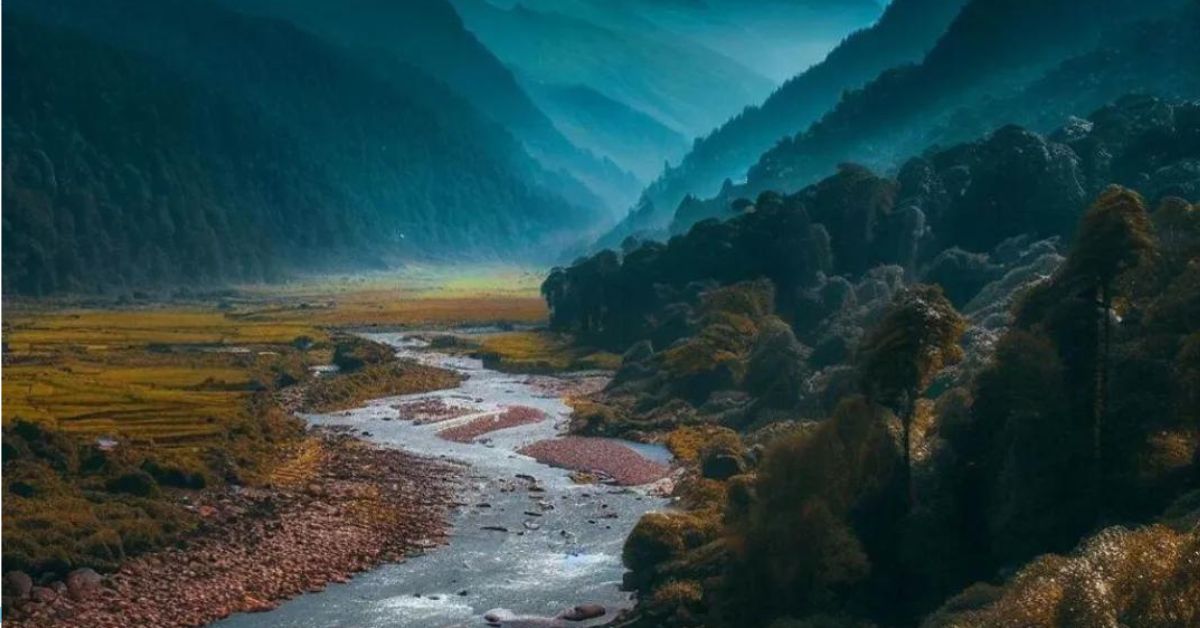Tucked away in the magical Arunachal Pradesh, Sangti Valley is a peaceful paradise that whispers promises of tranquility and stunning nature. Unlike the more famous spots, this hidden gem offers a special mix of beautiful views and local experiences you won’t find anywhere else. Surrounded by grand mountains and rolling green meadows, Sangti Valley is a haven for nature lovers and anyone seeking a break from the city noise.
Imagine this: breathtaking views that change with the seasons, painting the valley in a mesmerizing mix of colors all year round. Sangti Valley isn’t just a feast for the eyes, it’s also a cultural gem. Vibrant communities live here, keeping their traditional ways alive and adding a rich layer of culture to the valley.
How to reach:
By Air:
- Closest Airport: Tezpur Airport (TEZ) in Assam, around 120 kilometers away.
- Connections: This airport has flights from major cities like Guwahati and Delhi.
- Onward Journey: Taxis and local transport are available to take you to Sangti Valley. The trip usually takes 3-4 hours depending on road conditions.
By Train:
- Nearest Station: Tezpur Railway Station, about 115 kilometers from Sangti Valley.
- Connections: Tezpur is well-connected to major cities like Guwahati, which has direct trains.
- Onward Journey: Taxis and local buses can take you to Sangti Valley. The journey by road usually takes 3-4 hours.
By Road:
- From Guwahati: The capital city of Assam is roughly 230 kilometers away.
- Driving Time: The drive typically takes 6-8 hours, depending on traffic and road conditions. You can drive yourself or hire a taxi.
- Local Transport: Budget-friendly options like regular buses and shared taxis are available from Tezpur and other nearby towns. While these might be less comfortable, they’re a good way to save money.
Best time to visit:
Spring (March to May):
- Perfect weather: Pleasant temperatures (15°C to 25°C) make spring ideal for outdoor adventures. Explore the valley bathed in sunshine and vibrant with blooming flowers.
- Activities: Hike, sightsee, or simply soak in the picturesque beauty.
Summer (June to August):
- Warm and Wet: Temperatures range from 20°C to 30°C, but monsoon rains can cause occasional landslides and disrupt travel.
- The upside: Less crowded and lush greenery. If you enjoy rain and don’t mind the occasional downpour, summer offers a tranquil escape.
Autumn (September to November):
- Ideal weather: Comfortable temperatures (15°C to 25°C) with clear skies and minimal rain make autumn perfect for exploration.
- Activities: Go trekking, capture breathtaking mountain views, and witness the valley rejuvenated by the monsoon.
Winter (December to February):
- Chilly but beautiful: Temperatures drop to 5°C to 15°C, with even colder nights. Expect crisp mornings and evenings.
- Winter wonderland: Enjoy clear views of the valley and snow-capped peaks. This is a season for those who love cool weather and serene landscapes. You might even catch the Pangsau Pass Winter Festival nearby!
Attractions:
Sangti Valley Viewpoint:
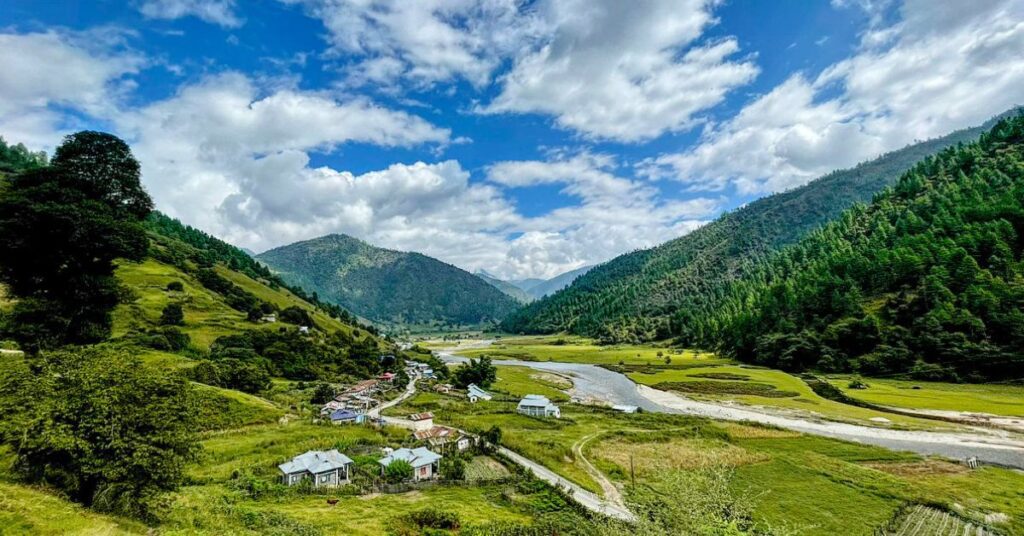
Tucked away in Arunachal Pradesh, Sangti Valley is a secret paradise. And there’s no better way to experience its magic than from the Sangti Valley Viewpoint. Imagine this: you stand on a hilltop, with a wide-open view stretching before you. Lush green valley unfolds like a carpet, dotted with rolling hills. Towering mountains stand guard all around, their peaks brushing the clouds. As the sun paints the sky with colors of sunrise or sunset, the whole scene comes alive. It’s a sight that will leave you speechless, perfect for capturing in photos or simply soaking in with your own eyes. The peacefulness of the viewpoint is another treasure. It’s a place to quiet your mind, breathe in the fresh air, and truly appreciate the beauty of nature. So, if you’re looking for a breathtaking view and a tranquil escape, Sangti Valley Viewpoint is a must-visit.
Sangti Village:
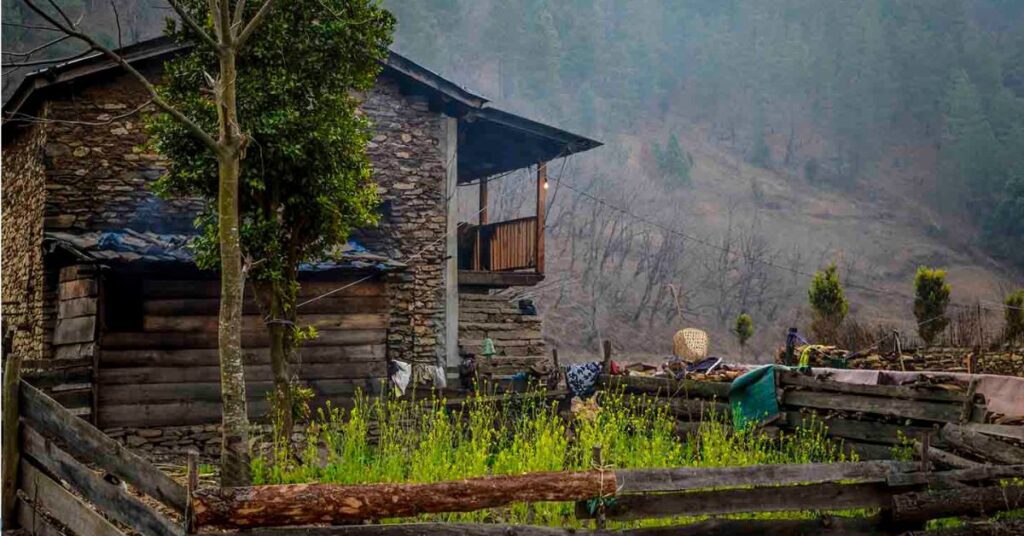
Deep in the heart of Sangti Valley lies a charming village where time seems to slow down. This is Sangti Village, a place brimming with Arunachali culture. Here, you’ll get a peek into the lives of local tribes who’ve kept their traditions alive for centuries.
Imagine strolling down narrow lanes lined with traditional wooden houses. You might even catch a glimpse of local artisans creating beautiful handmade crafts. The villagers here are known for their warm hospitality, and they’re happy to share their customs that have been passed down through generations.
Buddhist Monasteries:
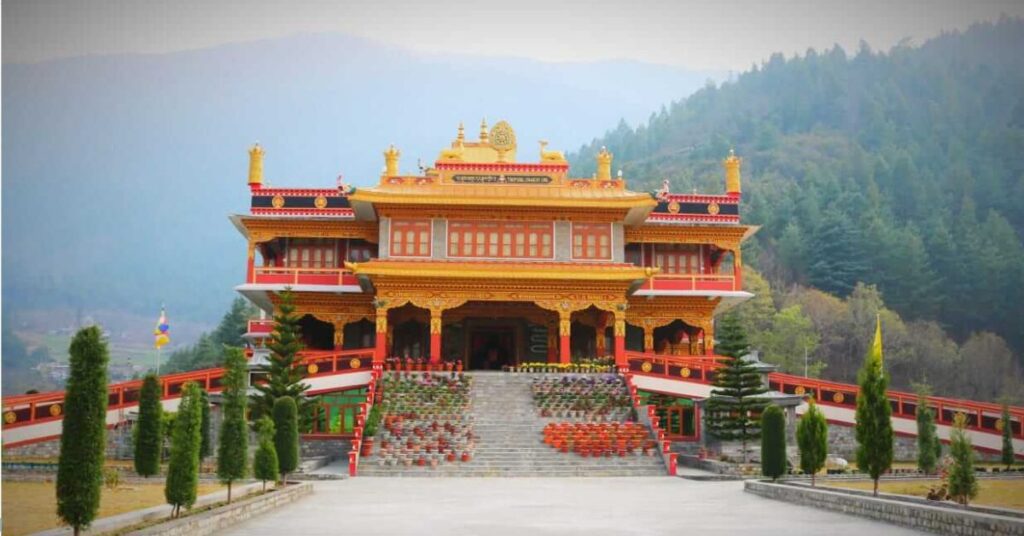
Absolutely! Tucked around Sangti Valley like hidden gems are Buddhist monasteries, adding a deep spiritual layer to the valley’s beauty. Imagine peaceful monasteries like the Chagdud Gonpa Rinpoche nestled amongst the mountains, their tranquility amplified by the stunning scenery. Visitors are welcome to explore these monasteries, marveling at their intricate architecture. You might even get a chance to witness traditional Buddhist rituals and gain a deeper appreciation for the spiritual practices that are so important to the local way of life. These monasteries offer a quiet haven for meditation and reflection, a perfect escape from the daily grind. It’s a chance to relax, connect with something larger, and gain a richer understanding of the religious traditions that are a cornerstone of Sangti Valley.
Sangti River:
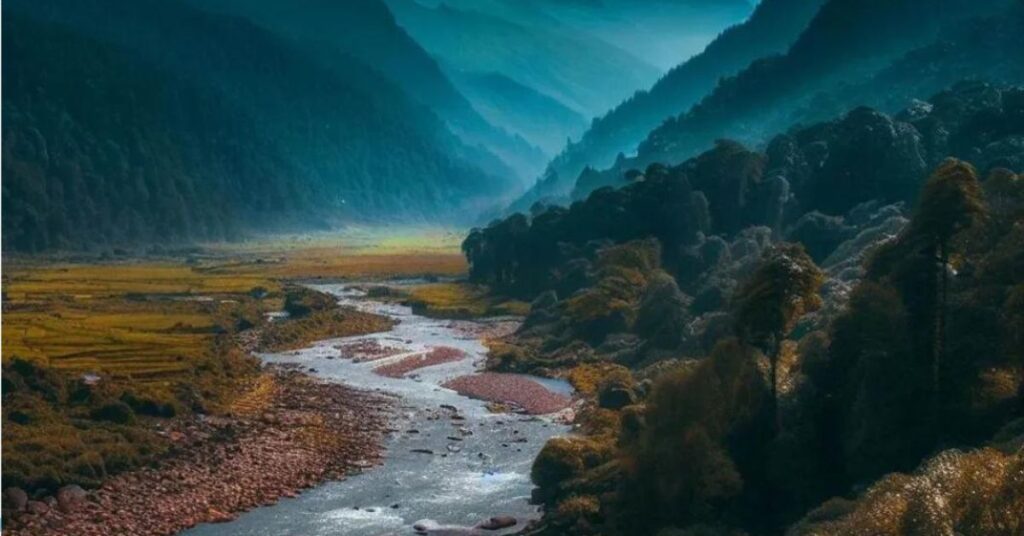
Ah, the Sangti River! It winds its way through the valley like a sparkling ribbon, adding another layer of beauty to the whole scene. The water is crystal clear, reflecting the lush green landscape that surrounds it. It’s the perfect spot for a relaxing afternoon. Imagine yourself by the riverbank, the gentle flow of the water creating a peaceful soundtrack. You can spread out a picnic lunch, take a nature walk along the riverside, or simply sit and soak in the beauty of the surroundings. The Sangti River is a true gem, offering a chance to unwind, reconnect with nature, and create memories that will last a lifetime.
Local Experiences:
- Traditional Farming: Witness or even participate in age-old farming practices used in Sangti Village. Learn about the cultivation of local crops like kiwi, apples, and apricots, and how these methods have been passed down through generations.
- Homestays: Experience true Arunachali hospitality by staying with local families in traditional homestays. You’ll enjoy delicious home-cooked meals and have the opportunity to exchange cultural stories with your hosts.
- Local Handicrafts: Discover the artistic side of Sangti Village by visiting local artisans who keep traditional crafts alive, like weaving and basket making. You can even take home a unique handmade souvenir directly from the craftspeople themselves.
- Village Walks: Embark on guided walks through Sangti Village to witness the daily life of the villagers. Explore their traditional homes and community spaces, and learn about their customs and traditions through interactions with the locals.
- Cultural Performances: Immerse yourself in the vibrant cultural heritage of the valley’s indigenous tribes by attending traditional dance and music performances during local festivals or special events.
- Fishing in the Sangti River: Cast your line in the Sangti River and try your hand at fishing using traditional techniques. Enjoy a peaceful day by the river and if you’re lucky, you might even catch your own dinner!
- Bird Watching: Join a bird-watching tour to spot the rare black-necked crane, a majestic migratory bird that visits the valley during winters. Learn about the local birdlife from knowledgeable guides and see a variety of other native bird species.
- Nature Walks and Picnics: Pack a picnic basket and enjoy leisurely walks through the valley’s meadows and forests. Find a scenic spot by the Sangti River or amidst the verdant landscape to relax and soak in the beauty of nature.
- Photography Expeditions: Capture the breathtaking landscapes, traditional village scenes, and the local wildlife of Sangti Valley on a guided photography tour. Learn new techniques and tips from experienced photographers to elevate your travel photography game.
- Monastery Visits: Spend a contemplative afternoon at nearby Buddhist monasteries, like the Chagdud Gonpa Rinpoche Monastery. Participate in meditation sessions and learn about Buddhist teachings and practices from the monks.
- Festivals Participation: Participate in local festivals like Losar, the Tibetan New Year, and witness traditional rituals, dances, and celebrations. Immerse yourself in the festive atmosphere and enjoy the communal spirit.
Travel tips:
- Time Your Trip: Research the best season for your interests. Spring offers pleasant weather, while winters have fewer crowds and the chance to see migratory birds. Festivals like Losar bring cultural immersion, but book accommodations well in advance during peak times.
- Pack Smart: Layer your clothing for changeable weather, especially in spring and fall. Pack rain gear and sturdy shoes for possible hikes.
- Permits: Obtain the Inner Line Permit (ILP) if you’re an Indian citizen, or the Protected Area Permit (PAP) if you’re from abroad. You can usually get these beforehand or upon arrival in Arunachal Pradesh.
- Travel Light: Pack only essentials – the terrain can be challenging, and lighter luggage makes things easier. Bring a small daypack for day trips.
- Be Prepared: Pack a basic first-aid kit, any medications you need, and remedies for common travel ailments. Consider recommended vaccinations for the region.
- Hydration and Snacks: Carry a reusable water bottle and refill it regularly. Pack energy bars or snacks, especially for longer walks or treks.
- Dress Modestly: Be mindful of local customs and dress modestly. Always ask permission before taking photos of people or entering private spaces.
- Eco-Friendly Travel: Be a responsible traveler. Use reusable items, avoid single-use plastics, and leave no trace by cleaning up after yourself.
- Limited Connectivity: Be prepared for limited mobile network coverage in remote areas. Pack a power bank and any necessary chargers.
- Cash is King: ATMs are scarce in remote areas, and many places may not accept card payments. Bring enough cash for your needs.
- Follow Local Advice: Heed local advice and guidelines about wildlife, especially on trekking paths. Inform someone about your itinerary and expected return times.
- Local Guides: Consider hiring local guides for trekking and tours. They offer valuable insights, ensure safety, and support the local economy.
- Observe Responsibly: Respect wildlife by maintaining a safe distance, avoiding feeding animals, and following park guidelines to minimize your impact on the environment.
Conclusion
Unveiling Sangti Valley’s magic awaits! This hidden gem in Arunachal Pradesh boasts breathtaking views, from panoramic vistas at the Sangti Valley Viewpoint to the serene Sangti River winding through verdant landscapes. Xplro.com, your travel companion, unlocks a unique experience beyond sightseeing. Immerse yourself in the rich cultural tapestry by staying in local homestays, participating in traditional farming, or witnessing vibrant festivals. Learn local crafts, savor delicious cuisine, and explore responsibly with our comprehensive guide. Respect the local culture and embrace eco-friendly practices. Xplro.com ensures your Sangti Valley adventure creates memories that last a lifetime.
FAQs
What makes Sangti Valley special?
- Sangti Valley is renowned for its stunning natural scenery, rich Arunachali culture, serene river, and excellent bird-watching opportunities, including the chance to see the rare black-necked crane.
How can I get to Sangti Valley?
- To reach Sangti Valley, you can travel by road from Bomdila or Tawang. The nearest airport is in Tezpur, and the closest railway station is also in Tezpur. From there, you can hire a taxi or take a local bus to the valley.
When is the best time to visit Sangti Valley?
- The best time to visit Sangti Valley is during spring (March to May) and autumn (September to November), when the weather is pleasant and ideal for exploring and outdoor activities.
Do I need a permit to visit Sangti Valley?
- Yes, Indian visitors need an Inner Line Permit (ILP), and foreign visitors require a Protected Area Permit (PAP). These permits can be obtained online or at designated offices within Arunachal Pradesh.
What types of accommodation are available in Sangti Valley?
- Accommodation options in Sangti Valley include homestays, guesthouses, and small lodges. Staying in a homestay offers a unique opportunity to experience traditional local hospitality and lifestyle.
What activities can I enjoy in Sangti Valley?
- Visitors to Sangti Valley can enjoy trekking, bird watching, fishing, nature walks, cultural tours, and participating in local festivals and traditional farming activities.
Is Sangti Valley good for trekking?
- Yes, Sangti Valley has several trekking trails that vary in difficulty. These trails traverse lush forests, meadows, and hills, offering beautiful views of the valley and surrounding mountains.
What wildlife can I see in Sangti Valley?
- Sangti Valley is home to various wildlife species, including the rare black-necked crane. The valley also supports diverse bird species and other local fauna.
Are there cultural events or festivals in Sangti Valley?
- Yes, Sangti Valley hosts cultural events and festivals, such as Losar (Tibetan New Year), featuring traditional dances, music, and rituals, providing insights into the local culture.
Is Sangti Valley a good place for photography?
- Definitely. The valley’s diverse landscapes, traditional village scenes, and vibrant cultural activities offer plenty of opportunities for photography. The changing light and seasonal variations add to the visual appeal.
Can I find local guides in Sangti Valley?
- Yes, local guides are available and can greatly enhance your experience by providing detailed information about the region’s history, culture, and natural beauty. Hiring a local guide is recommended for trekking and cultural tours.
What should I pack for a trip to Sangti Valley?
- Pack layered clothing to handle varying temperatures, comfortable trekking shoes, rain gear, a reusable water bottle, a first aid kit, necessary medications, and a camera. Carry enough cash, as ATMs might not be available in remote areas.




